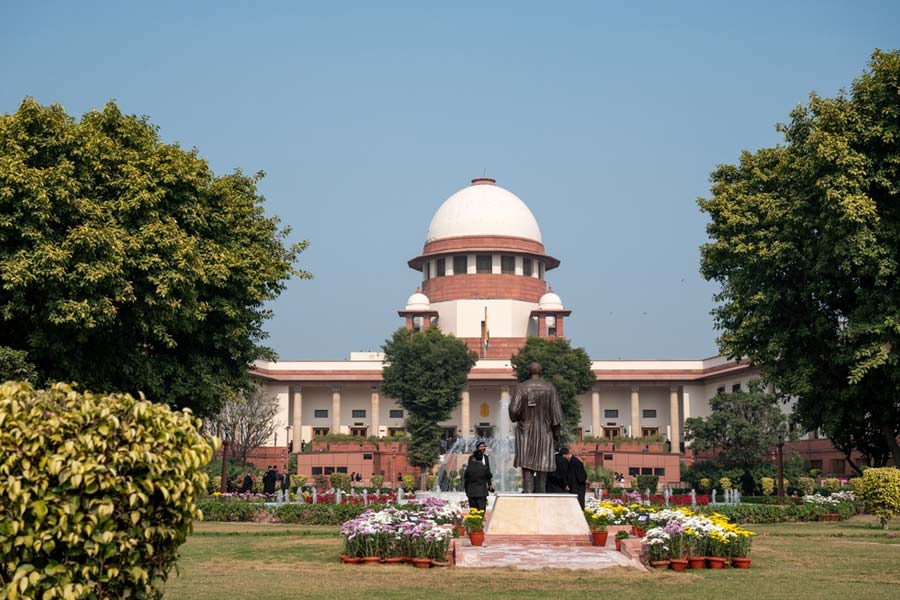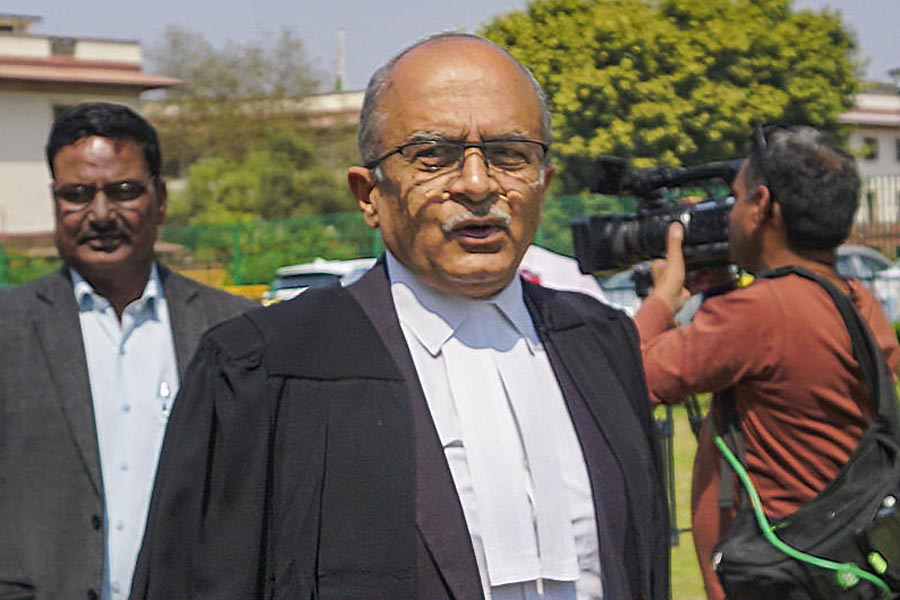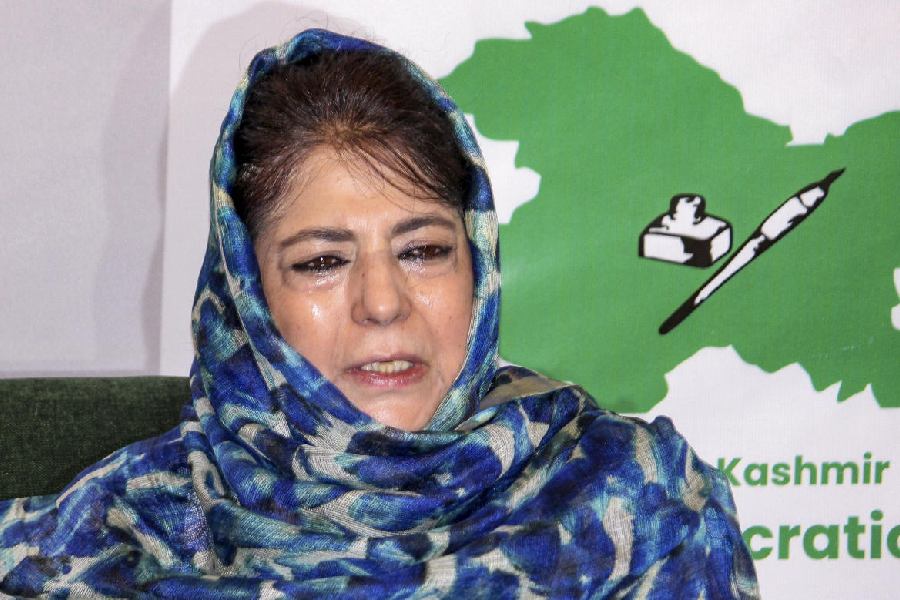 |
| Shahid Kapoor as Haider |
Srinagar, Nov. 1: The picture you see is not a still from Vishal Bhardwaj’s Haider. It could well have been.
There are countless tortured tales buried in Haider’s home landscape, only one could have been told in the course of a three-hour feature.
But in its telling, the makers of Haider have artfully exhumed a bibliography of horrors that has remained proscribed, or worse, condemned to indifference and denial.
The hyper-reality of Bollywood fare can often make light of gravity and fritter its essence away in bursts of hyperbole. Haider’s great virtue is that it does not succumb to the easy temptation of overstating; it is, if anything, a too delicately tempered rendition of a noir narrative.
Far more unspeakable things have happened in Kashmir than would pass muster with the censors. They defy the most dire imaginings of fiction.
This picture is from a village called Larnoo in a scenic recess of Kokernag in south Kashmir. The man in it is a father, and he is praying at the freshly bedded grave of his son, Abdul Rahman Padder. The year is 2007, and this graveside has just laid bare another of Kashmir’s grim tales.
The interred Abdul Rahman was a carpenter. He was also childhood friends with Farooq Ahmed Padder, his cousin and killer. This killer killed with licence; he was a policeman, constable Farooq Ahmed Padder, pride of Larnoo who became its dread.
 |
| Kay Kay Menon as Khurram in Haider |
He had hulk hands, he could dig a grave with his fingers, they said, a man built like a bear. He prowled like one too, picking victims with cunning, then making swift work of slaughter. He preyed with little effort, among his own.
Nazir Ahmed Deka, vendor of perfumes, was too a childhood friend and Larnoo neighbour. Ghulam Nabi Wani, the cloth hawker, was a mate from the village round the bend. So was Ali Mohammed Padder, petty government employee.
Abdul Rahman, the carpenter, was the closest to him, a first cousin and the lone son of frail old parents, father of five daughters, the youngest of whom was but three months.
Abdul Rahman was also worn of means and in need. He wanted a government job. He turned to constable Farooq, the village boy who had made it big. He promised to help.
He would speak to the right people and get his carpenter cousin a job, but it would cost him some. People want money, you see. Abdul Rahman borrowed and scrounged and gave the constable Rs 75,000. He vanished with the money.
Months went by. When Abdul Rahman pressed his cousin, he asked him to come see him in Srinagar. Abdul Rahman bussed down to make his appointment in Batmaloo, a busy Srinagar hub, but only to be bundled into an unmarked car.
That night he spent in the police lockup at Ganderbal, some 30km north of Srinagar. The following night he was shoved into the back of a police van, driven into the desolate woods of Waskar and shot dead by a combined party of policemen and paramilitary jawans.
So he couldn’t be identified, they ripped his face with bullets. Abdul Rahman, the carpenter of Larnoo, had become Abu Hafiz, dreaded terrorist from Multan in Pakistan.
They filed an FIR of the catch and killing; a dark crime became a badge of valour. The custodians of Ganderbal police — SSP Hans Raj Parihar, DSP Bahadur Ram, ASI Farooq Ahmed Guddoo — were rewarded for their gallantry, Rs 130,000 in cash.
Larnoo’s evil son earned his share of the booty for each man he supplied.
Wani, the cloth merchant, became Zulfiqar, Lashkar hitman; Deka, the perfume seller, became Abu Zubair, Pakistani militant; Ali Mohammed Padder was dismissed without a name, just a foreign militant.
And each kill put a shine on the prospects of the killers. In the noble pursuit of fighting the country’s war in Kashmir, they were lining their breasts with medals and their pockets with cash.
An unrelated accident unravelled constable Farooq’s grisly murders; he was caught operating a mobile SIM blackballed by the police. He sang long enough during interrogation to put himself in jail, along with SSP Parihar and DSP Bahadur Ram. They remain behind bars.
Constable Farooq’s story probably tells us why criminal wrongdoing has had such a successful and sustained outing in Kashmir. Here was a mere police constable but nobody in Larnoo dared take him on.
How could the poor of Larnoo take on a constable? That could mean their end. He could plant a rumour about your militant connections and set the task force upon you. Or he could plant a gun in your backyard and summon the army.
He knew powerful people. He had teamed up with SSP Parihar, who went on patting him on the back. Great job, Padder, keep knocking them. It was good for the case diaries. It was good for SSP saheb, he stood apart with a better kill rate when he went to the monthly operational meetings at headquarters.
It was good for Mother India. Constable Farooq was good for Mother India. That’s the fearsome rot Kashmir is in. That’s what Haider is able to capture and convey, often through the charming expedient of farce.
What’s, after all, to separate the serial perfidy of Haider’s singing Salmans from the chutzpah of constable Farooq? Or the sinister deceit of Kay Kay Menon’s Khurram from the murderous career of Kuka Parray, sarkari assassin?
When Parray, also elected MLA like Khurram in the rifle-butt polls of 1996, was killed, the village of Hajin didn’t allow its native space in the communal graves; he had to be slid six feet under his front lawn.
Haider, in many senses, is its own act of chutzpah, an audacious dive into a macabre womb to grab a plot far more complex than merely the familiar and simplistic narrative of Kashmir’s thwarted political aspiration. It is the gift of a haunted Kashmir to Kashmiris.
Here, this is what was done to you, and this is what you did to yourselves. It is not content sitting this side or that; it tells you there are fences everywhere, even in beds and bedrooms. It tells you how unrelieved turbulence can twist and pervert the human condition.
Above the daily humdrum Kashmir floats a pensive, un-assuaged air so insistent it makes prayer sound like a dirge. By twilight, it has risen from the houses of God and become a shroud that defies cameras as well as it defies banishment — “Hamaara aasmaan kaale parindon se ghira hua hai…Our skies are besieged by ravens….”
Nobody will forget their dead, nobody will cease waiting for the vanished. What’s the count? But don’t even get there, the numbers are too high and it’s not the numbers, it’s people.
Parents, children, siblings, spouses buried, or worse, missing without trace. Crying resumes each evening beneath the portals of mosques and shrines and rises aloft that shroud to the skies. No place has cried so uninterrupted as Kashmir, it has cried so long that crying has become its song.
That crying is Haider’s background score. And if it has fallen on deaf ears in a constituency that cannot tire of decrying Vishal Bhardwaj’s third Shakespearean adaptation, if it has stoked raging arguments over right and wrong, that too must count as part of Haider’s success.
Kashmir’s reality remains both divisive and divided, a place tragically broken upon itself. In a classic moment, Tabu’s Ghazala comes to enact Haider’s — and Kashmir’s — metaphoric moment.
She has stepped into the ghastly carcass of her charred bungalow, and as she finds her reflection in a framed mirror, it cracks in two and splits her up: Ghazala, half widow and half bride, grieving and guilty.
That’s Kashmir, paradise and hell, nightmare and past and future dream. It’s what the pose of the man in the picture may be too: a lament, and a prayer.
 |
THE STORY BEHIND THE PICTURE
When the cold-blooded murders ordered by the Ganderbal police brass came to light in 2007, it quickly became clear that the killer and most of his victims came from the same village in the upper reaches of Kokernag in south Kashmir: Larnoo.
I happened to be in Srinagar on assignment at the time and decided to go because I heard some of the victims’ exhumed remains had been returned to their families. When
I reached Larnoo, a three-hour drive from Srinagar, the burial of carpenter Abdul Rahman Padder, had just been concluded.
It was February and Larnoo lay mired in the muddy leftovers of melted snow. The entire village was gathered around the Padders’ home, shocked, silent, seething. I sat awhile among the mourners, and then asked Abdul’s father if I could see where they had lain his son to rest.
The old man held my hand and led me to a clearing in the woods on the verge of the village and pointed to an oblong mound of earth. It had been raining, and so to protect Abdul’s final place of rest villagers had covered it with bales of hay. He fell upon his knees and began to pray, and that is how this picture came to be taken.
SANKARSHAN THAKUR










